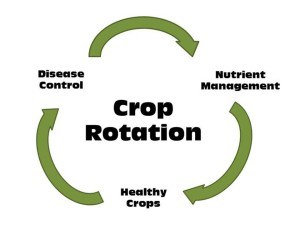The concept of crop rotations has fallen out of favor lately, whether it’s due to economics, lovely Mother Nature, or logistics in the busy season. I think that it is time to revisit this concept and to understand why it has been promoted in the past.
Crop rotations are designed for improving crop and soil health over the long term and some would argue economics too, all to ensure sustainability. I really want to emphasize sustainability, as many producers seem to not be considering this. If you have a son that will be taking over the farm or are a young producer, think about the issues and consequences of less crop diversification and tight crop rotations 10, 20, 30, and 40 years down the road. Crop rotations are a great way to lessen these risks and consequences as they keep pests off balance, while maintaining soil nutrient levels and using water and nutrients efficiently.
Herbicide resistant weeds and weed management are issues associated with tight crop rotations, where the same crop is grown and a similar herbicide is used year after year. Plants are smarter than we give them credit and adapt to our farming practice and eventually the weed population shifts to weed species that are resistant to that herbicide or mode of action. Herbicide resistance develops from a genetic mutation or natural tolerance in a weed population and if the same herbicide or mode of action is continually used, that weed does not die and goes to seed and spreads, then you have more and more herbicide resistant weeds to deal with. Once they are present, they are a long-term tenant on farmland.
Minimizing disease levels is also an important aspect of crop rotations; which reduce the growth, reproduction and survival of soil stubble borne pathogens, which cannot survive without a susceptible host or plant tissue. Crop rotations will not eliminate these pathogens, but will reduce their population size so that there is less crop damage and control options will become more effective. Rotation of fungicide groups and modes of action will ensure fungicide efficacy. Using one, single mode of action fungicide year after year will select for organisms that have resistance to the fungicide or mode of action and soon the fungicide will not be effective against the disease. Selecting a variety with disease resistance will also help, but do not only depend on that as resistance will break down and new strains, with no known resistance are discovered.
Crops have different rooting depths to capture nutrients and water. Peas, lentils, and flax have shallow root systems, while cereals crops have a deep rooted fibrous root system, followed by canola and mustard with a deep rooted taproot, and alfalfa with a very deep rooted taproot. The deep rooted taproot allows the plants to obtain nutrients such as nitrogen and sulfur that leach down in the soil profile, especially in these wet years. Shallow roots and the fibrous roots system of cereal crops allows to capture phosphorus and potassium, which from seeding are higher up in the soil profile and move only a few mm in the soil every year.
As well, including pulse crops in crop rotations is a way to get free nitrogen from the crop when it is inoculated. Pulse crops fix 50-90% of their nitrogen. Faba bean fixes 90%, 80% for pea and lentil, 70% for chick pea and 50% for soybean and dry bean and these crops leave residual nitrogen for the following crop as pulse stubble is broken down relatively quickly.
At the end of the day, I understand that economics and Mother Nature play a big role is choosing crop rotations. I wanted to provide some food for thought.




